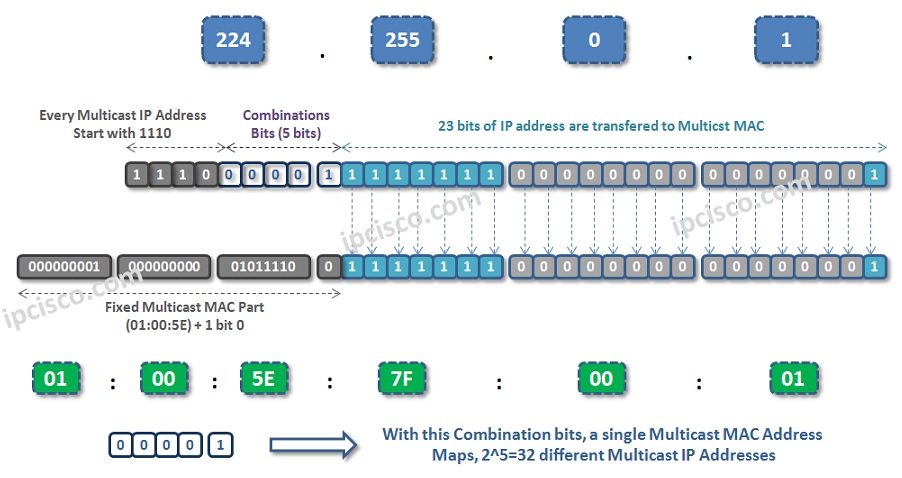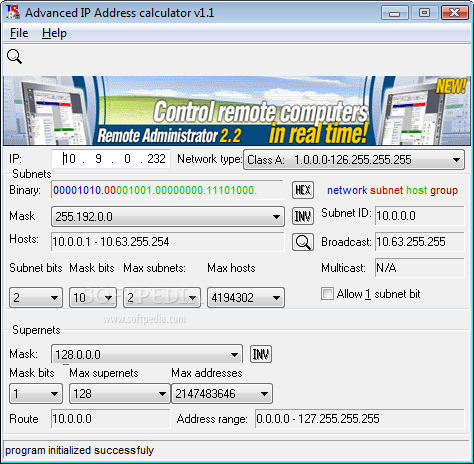
- MULTICAST IP ADDRESS CALCULATOR HOW TO
- MULTICAST IP ADDRESS CALCULATOR FOR MAC
- MULTICAST IP ADDRESS CALCULATOR FULL
- MULTICAST IP ADDRESS CALCULATOR MAC
We will take the blue and green digits and put the red digits behind them: 1110 0000
MULTICAST IP ADDRESS CALCULATOR MAC
The green digits are the 5 bits that we lose because we have to map a 28 bit unique multicast IP address to a 23 bit multicast MAC address. The digits in blue (1110) are the class D IP address in binary (224 in decimal). Now we will take the class D multicast IP address range in binary: 1110 0000 The bits that I highlighted in red are the lowest 23 bits of the MAC address. Now we will take the lowest 23 bits of this MAC address: 0000 0001
MULTICAST IP ADDRESS CALCULATOR FULL
We will take the following multicast MAC address and calculate what 32 multicast IP addresses map to it:įirst we have to translate this MAC address from hexadecimal to binary: 0Ībove you can see how I translated the hexadecimal address into binary, this is the full MAC address: 0000 0001 You can use the following table to calculate between decimal, hexadecimal and binary: Decimal
MULTICAST IP ADDRESS CALCULATOR HOW TO
Let’s take a look at how to do this!įirst we’ll figure out which multicast MAC address maps to which 32 multicast IP addresses. Now the big question remains…what multicast IP addresses map to which multicast MAC address and how do we calculate this? You can use a calculator of course but if you are studying for a Cisco exam you don’t have this luxury. The host will have to look at the IP address of the received frame to see if it’s for 239.1.1.1 and discard frames that are meant for 224.1.1.1. If someone else is streaming to the 224.1.1.1 multicast IP address it will also end up at our host because the MAC address is the same. For example, a host that listens to the 239.1.1.1 multicast IP address will configure its network card to listen to MAC address 01-00-5E-01-01-01. This can cause some problems in our networks. The multicast IP addresses above all map to the same multicast MAC address (01-00-5E-01-01-01). This means we will map 32 multicast IP addresses to 1 multicast MAC address. We miss 5 bits of mapping information: 2 5 = 32. We don’t have enough MAC addresses to give each multicast IP address its own MAC address. This means that we have to map multiple Multicast IP addresses to the same Multicast MAC address. Now if we want to map our 28 bit multicast IP address to our 23 bit MAC address we have a problem…we miss 5 bits of mapping information: This means that each multicast IP address has 28 unique bits. A multicast IP address also has 32 bits but the first 4 bits are always the same (1110) because we use the 224.0.0.0 – 239.255.255.255 range. Why does this matter? Let me show you:Ībove you see an IP address which has 32 bits. As a result Steve’s manager bought a single OUI (24 bit) and gave half of the space (23 bit) to Steve to use for his multicast research.
MULTICAST IP ADDRESS CALCULATOR FOR MAC
each OUI has 24 bits of address space, so 16 x 24 bits would supply enough MAC addresses to create a 1:1 relation between multicast IP address and multicast MAC address.Įach OUI costed $1000 and Steve’s manager didn’t want to pay 16 x $1000 = $16.000 just for MAC address space. There’s a funny story why we only have 23 bits left…back in the days (1990 something) Steve Deering was working on his research on IP multicast and he wanted the IEEE to assign 16 OUIs (Organizational Unique Identifiers) to IP multicast MAC addresses. I just told you that only half of this 24-bit space is available to us which means that only 23 bits can be used. This means there are 8+8+8 = 24 bits left for us to use. Here’s an illustration:Īs you can see the first 3 octets are 01-00-5E.

Unfortunately only half of the MAC addresses in this 24-bit prefix can be used for multicast, this means we only have 23 bits of MAC address space to use for multicast. The 24-bit MAC address prefix 01-00-5E is reserved for layer 2 multicast. What about layer 2? What MAC addresses do we use for multicast traffic?įor layer 2 we also have a reserved prefix to use for multicast traffic. On layer 3 IANA has reserved the class D range (224.0.0.0 – 239.255.255.255) for multicast IP addresses.

For broadcast or multicast traffic this bit will be set to 1. When we have unicast traffic this bit will be set to 0.

In the first octet, bit 0 has been reserved for broadcast or multicast traffic. Multicast IP address live in the 224.0.0.0 – 239.255.255.255 range but what about MAC addresses and Ethernet frames? What do we do on layer 2 to make multicast work? Let me show you an example of a MAC address:Ībove you see an example of a MAC address.


 0 kommentar(er)
0 kommentar(er)
